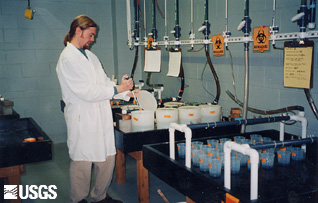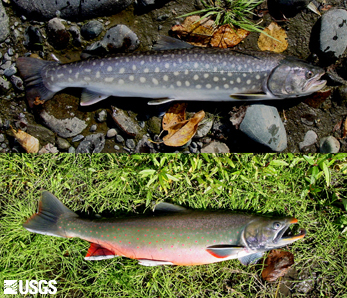- Home
- About S&T
- Taxa/Organisms
- Ecosystems
- Issues
- Methods & Tools
- Reports & Publications
- Location
- Search
2008 | Publisher: USGS | Science Center: Fort Collins Science Center (FORT, Ft. Collins) | Format: URL
www.fort.usgs.gov — With the exception of Aspen, coniferous species dominate the forests of the Rocky Mountains (Populus tremuloides Michx.; Peet, 2000). The establishment of new aspen stands in the central Rocky Mountains generally follows major disturbances, particularly forest fires, with new stems sprouting from surviving root systems and with rare establishment More...

2007 | Publisher: USGS | Science Center: Western Ecological Research Center (WERC, Sacramento) | Format: .PDF
www.werc.usgs.gov — The Alameda whipsnake (Masticophis lateralis euryxanthus) is both a federally and state listed endangered species limited to scrub and chaparral habitat within Contra Costa and Alameda Counties, CA. Loss and fragmentation of habitat due to agricultural and urban development over the last 100 years are cited as the main causes of its decline. Based More...

2007 | Publisher: Other (Blackewll Publishing Company) | Format: URL
biology.usgs.gov — This resource is a glossary of terms that assist in the interpretation and understanding of genetics resources found on the Genetics and Genomics website of the United States Geological Survey (USGS). The following glossary was made available to the Genetics and Genomics project website, with special permission obtained from the following More...

2007 | Publisher: NBII | Format: URL
www.nbii.gov — This site is a primary and supplemental resource focused on non-human aspects of genetic biodiversity. The scope of the National Biological Information Infrastructure is on non-human biological and natural resources. Users can link to the following topics: Genetic Diversity, Agriculture & Genetic Diversity, Basic Genetics

September 2005 | Publisher: USGS (Soundwaves) | Science Center: USGS Other | Format: URL
soundwaves.usgs.gov — Biologists in the Sirenia Project at the U.S. Geological Survey (USGS) Florida Integrated Science Center (FISC) in Gainesville, FL, are currently identifying and mapping the genetic material of manatees. Their goal is to better understand and predict the manatee's ability to react to environmental stimuli, such as prolonged periods of cold More...

Publisher: USGS | Science Center: Western Fisheries Research Center (WFRC, Seattle) | Format: URL
wfrc.usgs.gov — Viral infections are common causes of disease outbreaks and mortalities in both wild and captive fish populations. Due to the long history of virus outbreaks there is a substantial body of knowledge about viruses within the field of fish pathology. This project involves research and development studies which create, modify and apply modern More...

Publisher: USGS | Science Center: Leetown Science Center (LSC, Kearneysville) | Format: URL
www.lsc.usgs.gov — The primary goal of this study is to clarify how riparian zone and land use affect T. tubifex population density, lineage and myxosporidian parasite density and/or the ability of resident worms to become infected with M. cerebralis spores and to release infective spores. Preliminary results suggest that a deciduous riparian zone reduces the More...

Publisher: USGS | Science Center: Forest and Rangeland Ecosystem Science Center (FRESC, Corvallis) | Format: URL
fresc.usgs.gov — Conservation Genetics of Shorebirds uses molecular techniques to describe genetic structure and diversity in North American shorebirds (order: Charadriiformes) to facilitate population maintenance and recovery of these migratory birds.

Publisher: USGS | Science Center: Western Fisheries Research Center (WFRC, Seattle) | Format: URL
wfrc.usgs.gov — This U.S./Russian collaboration will investigate genetics and life histories of Kamchatka Peninsula rainbow trout and steelhead (O. mykiss), and Dolly Varden, white-spotted, and arctic char (S. malma, S. leucomaensis, and S. alpinus, respectively). Both anadromous and resident forms of these generally occur in Kamchatka rivers that are free from More...

Publisher: USGS | Science Center: Northern Rocky Mountain Science Center (NRMSC, Bozeman) | Format: URL
www.nrmsc.usgs.gov — The grizzly bears in Glacier National Park represent the keystone of the Northern Continental Divide Ecosystem population in NW Montana. Because of its proximity to Canadian bear populations, large land area, and high proportion of designated wilderness and national park lands, the Northern Continental Divide Ecosystem has the best long-term More...

Publisher: USGS | Science Center: Northern Rocky Mountain Science Center (NRMSC, Bozeman) | Format: URL
www.nrmsc.usgs.gov — Remote cameras are used world-wide to address a variety of research and management objectives for wildlife species that are often difficult to find track, and capture. This project investigates how grizzly bears (Ursus arctos) and black bears (U. americanus) and other wildlife species respond to baited, barbed wire hair traps, providing more More...

Publisher: USGS | Science Center: Western Ecological Research Center (WERC, Sacramento) | Format: URL
www.werc.usgs.gov — Conservation Genetics researchers at the USGS San Diego Field Station are currently using genetic techniques to investigate the population structure of several species of concern and to investigate links between Southern California geography and patterns of genetic diversity across different species groups. This resource also links to other More...
